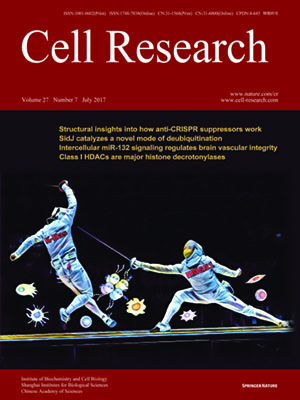
Volume 27, No 7, Jul 2017
ISSN: 1001-0602
EISSN: 1748-7838 2018
impact factor 17.848*
(Clarivate Analytics, 2019)
Volume 27 Issue 7, July 2017: 950-953
LETTERS TO THE EDITOR
Optogenetic activation of dorsal raphe neurons rescues the autistic-like social deficits in Shank3 knockout mice
Junyu Luo1, Qiru Feng1, Liping Wei2,3 and Minmin Luo1,3
1Peking University-Tsinghua University-National Institute of Biological Sciences (PTN) Joint Graduate Program, School of Life Sciences, Tsinghua University, Beijing 100084, China
2School of Life Sciences, Peking University, Beijing 100871, China
3National Institute of Biological Sciences, Beijing 102206, China
Correspondence: Liping Wei, Tel: 010-80723791 E-mail: weilp@mail.cbi.pku.edu.cn; Minmin Luo,(luominmin@nibs.ac.cn)
Impaired social interaction is one of the core symptoms of the autism spectrum disorder (ASD)1. However, the etiology and neural circuit mechanisms underlying these behavioral impairments are not well understood2. Currently, behavioral therapies are the most effective interventions for ASD, although the benefits from such treatments are minimal3,4. Here, we demonstrate that the autistic-like social deficits of Shank3 knockout mice5 can be durably rescued by social training coupled with optogenetic activation of neurons in the midbrain dorsal raphe nucleus (DRN) — a region encoding reward through 5-HT and glutamate6. A single training session resulted in a significant rescue effect on social preference, and such rescue effect was retained for several days with increased neuronal activation in the DRN when facing social stimuli. Multiple training sessions resulted in much longer-lasting rescue effects. Intriguingly, the durable rescue effect was generated by stimulating Pet-1 neurons in the DRN, but not by stimulating dopamine neurons in the ventral tegmental area (VTA) — the classical reward center. Our results suggest that the DRN should be viewed as an attractive target for future ASD interventions.
10.1038/cr.2017.52
FULL TEXT | PDF
Browse 2105


